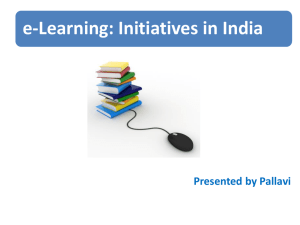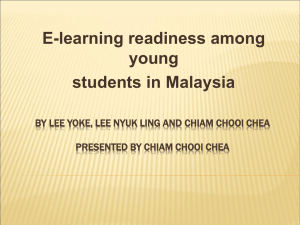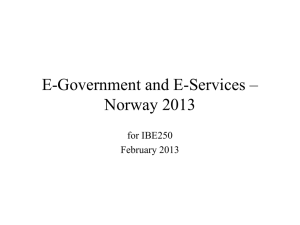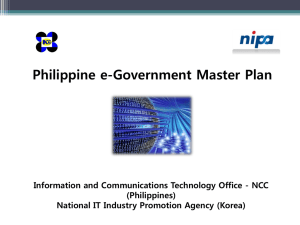E-Government
advertisement
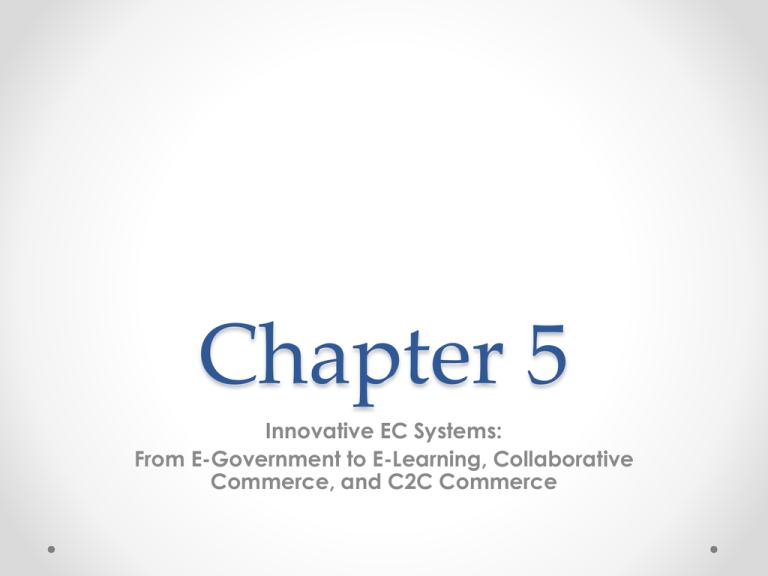
Chapter 5 Innovative EC Systems: From E-Government to E-Learning, Collaborative Commerce, and C2C Commerce Learning Objectives 1. Describe various e-government initiatives. 2. Describe e-government activities and implementation issues including government 2.0 and m-government. 3. Describe e-learning, virtual universities, and e-training. 4. Describe e-books and their readers. 5. Describe knowledge management and dissemination as e-commerce. 6. Describe and discuss online advisory systems. 7. Describe collaborative commerce. 8. Describe C2C activities in e-commerce. E-Government: An Overview • Definition and Scope o *E-government • *Government-to-Citizens o *Electronic Voting o Electronic Benefits Transfer • *Government-to-Business o Government E-Procurement o Group Purchasing o Forward E-Auctions • *Government-to-Government E-Government Categories of Activities The Process of Using a Voting Machine E-Government: An Overview • Government-to-Employees and Internal Efficiency and Effectiveness o *Government-to-Employees (G2E) o Internal Efficiency and Effectiveness (IEE) • Implementing E-Government • The Transformation to E-Government • E-Government 2.0 and Social Networking o *Government 2.0 o The Potential of E-Government 2.0 E-Government: An Overview • M-Government o o o o *Mobile government (m-government The Benefits of M-Government Some Implementation Issues Applications E-Learning, E-Training, and E-Books • The Basics of E-Learning: Definitions and Concepts o *E-Learning o *M-Learning The Drivers of E-Learning E-Learning, E-Training, and E-Books • Benefits and Drawbacks of E-Learning o Benefits of E-Learning • • • • • • • • • • • • • Education Learning and training time reduction Cost reduction Large number and diversity of learners Innovative teaching Measurement and assessment of progress Self-paced and motivation learning Richness and quality Flexibility Updated and consistent teaching material Ability to learn from mobile devices Expert knowledge Fear-free environment The Engkey – Robot English Teacher Source: The Korea Advanced Institute of Science and Technology. Used with permission. E-Learning, E-Training, and E-Books o Drawbacks and Challenges of E-Learning • • • • • • • Need for instructor retraining Equipment needs and support services Lack of face-to-face interaction and campus life style Assessments and examinations Maintenance and updating Protection of intellectual property Student retention • Distance Learning and Online Universities o *Distance learning o *Virtual Universities--Real Degrees o Innovations in E-Learning E-Learning, E-Training, and E-Books • Online Corporate Training o Using Computer Games for Training Current and New Employees • Social Networks and E-Learning o *Social learning • Learning in Virtual Worlds and Second Life • Visual Interactive Simulation o Learning On-Demand • *E-Learning Management Systems E-Learning, E-Training, and E-Books • *Electronic Books (E-Books) o o o o Devices for Reading E-Books Combining E-Readers and Tablets Advantages and Limitations of E-Books A Final Note: Is This the End of Printed Books? Knowledge Management, Advisory Systems, and Electronic Commerce • An Overview of Knowledge Management o *Knowledge management (KM) • Knowledge Management Types and Activities o o o o o o Create knowledge Capture knowledge Refine knowledge Store knowledge Update knowledge Disseminate knowledge The Knowledge Management System Cycle Knowledge Management, Advisory Systems, and Electronic Commerce • Knowledge Sharing o Software Tools for Knowledge Sharing • How Is Knowledge Management Related to E-Commerce? • KM and Social Networks o Deploying KM Technologies Knowledge Management, Advisory Systems, and Electronic Commerce • Finding Expertise and/or Experts Electronically and the Use of Expert Location Systems o Answers Provided by People at Social Networks or Portals o *Automated Question-Answer Systems o Live Chat with Experts o *Expert/expertise location systems (ELS) o Seeking Expertise in Social Networks AskMe’s Expert Location System Collaborative Commerce • Essentials of Collaborative Commerce o *Collaborative commerce (c-commerce) o *E-collaboration • The Elements and Processes of CCommerce • *Collaboration Hub (c-hub) o Improving Collaborative Commerce Elements and Process of C-Commerce Systems Collaborative Commerce • Representative Examples of Collaborative Commerce o o o o o *Vendor-managed inventory (VMI) Retailer-Supplier Collaboration Reducing Transportation and Inventory Costs Reduction of Design Cycle Time Elimination of Channel Conflict: Collaboration with Dealers and Retailers • Barriers to C-Commerce o Overcoming Barriers to E-Collaboration • Collaboration Processes and Software Target’s Extranet Consumer-to-Consumer Electronic Commerce • *Consumer-to-consumer (C2C) EC • E-Commerce: C2C Applications o C2C Auctions o Selling and Buying in C2C • Person-to-Person Money Lending o o o o Classified Ads Personal Services File-Sharing Utilities: Napster and Others C2C Activities in Social Networks and Trading Virtual Properties Managerial Issues 1. How do we design the most cost-efficient government e-procurement system? 2. How do we design the portfolio of e-learning knowledge sources? 3. How do we incorporate social networking-based learning and services in our organization? 4. What will be the impact of the e-book platform? 5. How difficult is it to introduce e-collaboration? 6. How much can be shared with business partners? Can they be trusted? 7. Who benefits from vendor-managed inventory? Summary 1. E-government activities. 2. Implementing e-government to citizens, businesses, and its own operations. 3. E-learning and training. 4. E-books and their readers. 5. Knowledge management and dissemination. 6. Online advisory systems. 7. C-commerce. 8. C2C activities.


